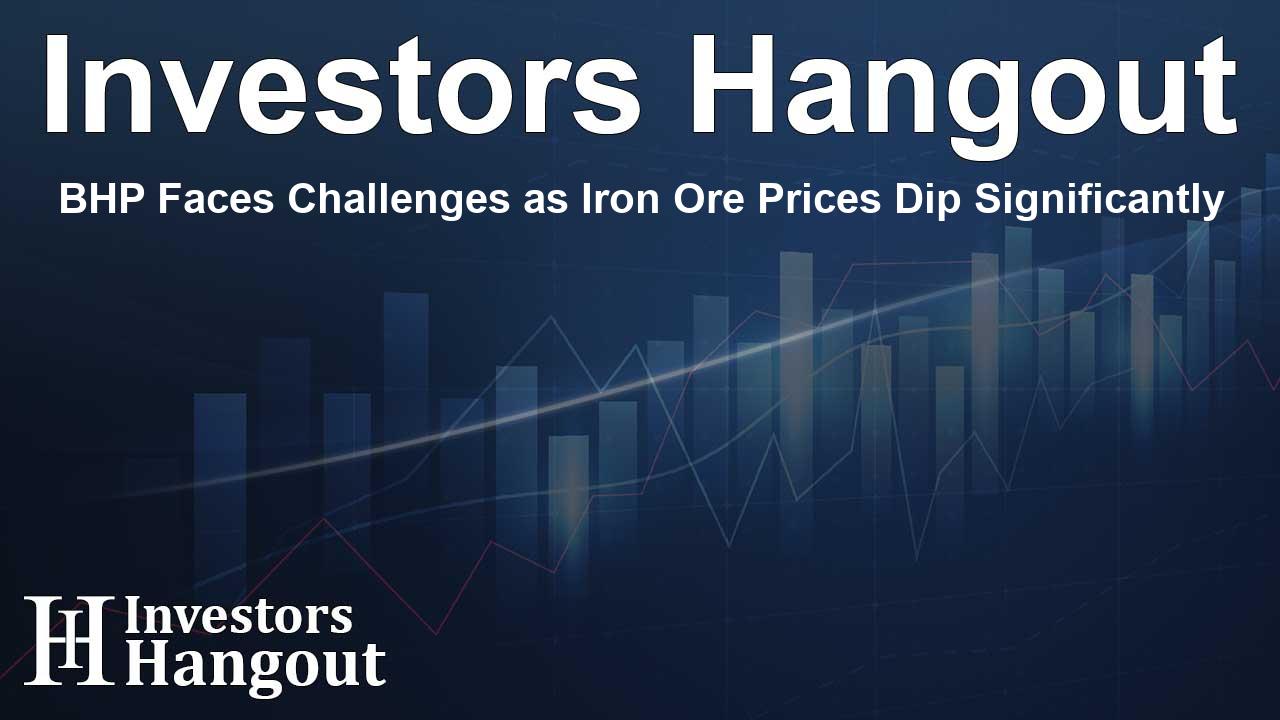BHP Faces Challenges as Iron Ore Prices Dip Significantly

BHP Posts Weakest Earnings in Five Years
The leading global miner BHP Group (NYSE: BHP) has reported its most challenging financial results in five years, largely attributable to the downturn in iron ore prices and reduced steel demand from China. The firm revealed an underlying attributable profit of $10.16 billion, a significant 26% decrease compared to the previous year.
Declining Iron Ore Prices Affect Performance
This downturn marks the weakest performance for BHP since the year 2020. A significant 19% decline in realized iron ore prices was a primary contributor to this result, triggered by increased supply from Australia, Brazil, and South Africa, coinciding with a faltering demand from China. However, firmer copper prices provided some mitigation to the overall negative impact, as record outputs from key markets helped to balance the weakness in bulk commodities.
Dividend Distribution Reduces
BHP announced a final dividend of 60 cents per share, compared to 74 cents from last year, culminating in a total payout of $1.10 per share for the year. Though this amount exceeded consensus forecasts, it remains the company’s lowest annual distribution since 2017, reflecting the pressures on earnings.
Adjusting to Market Dynamics
CEO Mike Henry commented, "Policy uncertainty surrounding tariffs, fiscal policy, and industrial policy remains high, influencing investment and trade flows. Nevertheless, commodity demand has shown resilience." This suggests that even amid difficulties, there are areas of strength and opportunity within the commodity market.
Investment Plans and Future Outlook
Looking towards the future, BHP intends to ramp up its near-term investments. The company plans to invest $11 billion annually in growth projects and exploration over the next two years, a rise from the approximately $9.8 billion allocated in the current fiscal year. It also anticipates that annual investments will trend towards $10 billion from 2028 through 2030.
Commitment to Sustainability
Henry reiterated the company’s dedication to sustainability, aiming for a 30% reduction in greenhouse gas emissions by fiscal year 2030 relative to a fiscal year 2020 baseline. This commitment underscores BHP’s intention to integrate environmental considerations into its growth strategy.
Potential Growth Areas
In terms of market opportunities, BHP sees a promising outlook for copper and fertilizers despite potential for near-term volatility. The demand for copper, particularly, is anticipated to remain robust, supported by infrastructure development in regions such as China and India. Moreover, the Jansen potash project in Canada is slated to commence production in 2027, providing a vital growth opportunity in the fertilizers sector.
Market Reactions
As market analysts monitor BHP’s performance, Berenberg analyst Richard Hatch has recently downgraded BHP from Hold to Sell, with a target price set at $44. The company’s stock performance has shown a slight uptick, recently trading up by 2.58% at $54.81 during pre-market hours.
Frequently Asked Questions
What is BHP's current stock ticker?
BHP trades under the ticker symbol BHP on the NYSE.
How much profit did BHP report this year?
BHP reported an underlying attributable profit of $10.16 billion, which reflects a 26% decline from the previous year.
What is BHP's plan for dividends?
BHP declared a final dividend of 60 cents per share for this year, which is lower than the 74 cents declared last year.
What are BHP's sustainability goals?
The company aims to reduce greenhouse gas emissions by 30% by fiscal year 2030 compared to the fiscal year 2020 baseline.
What investment allocation is planned for the future?
BHP is planning to allocate $11 billion annually to growth projects and exploration over the next two years.
About The Author
Contact Owen Jenkins privately here. Or send an email with ATTN: Owen Jenkins as the subject to contact@investorshangout.com.
About Investors Hangout
Investors Hangout is a leading online stock forum for financial discussion and learning, offering a wide range of free tools and resources. It draws in traders of all levels, who exchange market knowledge, investigate trading tactics, and keep an eye on industry developments in real time. Featuring financial articles, stock message boards, quotes, charts, company profiles, and live news updates. Through cooperative learning and a wealth of informational resources, it helps users from novices creating their first portfolios to experts honing their techniques. Join Investors Hangout today: https://investorshangout.com/
The content of this article is based on factual, publicly available information and does not represent legal, financial, or investment advice. Investors Hangout does not offer financial advice, and the author is not a licensed financial advisor. Consult a qualified advisor before making any financial or investment decisions based on this article. This article should not be considered advice to purchase, sell, or hold any securities or other investments. If any of the material provided here is inaccurate, please contact us for corrections.
